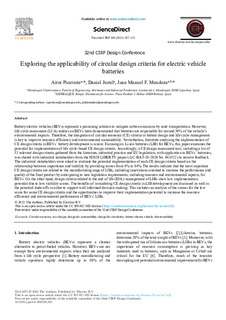
Título
Exploring the applicability of circular design criteria for electric vehicle batteriesVersión
Version publicada
Derechos
© 2022 The AuthorsAcceso
Acceso abiertoVersión del editor
https://doi.org/10.1016/j.procir.2022.05.222Publicado en
Procedia CIRP. Vol. 109. Pp. 107-112. Elsevier, 2022Editor
ElsevierPalabras clave
Circular economy
eco-design
design for sustainability
design for circularity ... [+]
eco-design
design for sustainability
design for circularity ... [+]
Circular economy
eco-design
design for sustainability
design for circularity
battery electric vehicle
electromobility [-]
eco-design
design for sustainability
design for circularity
battery electric vehicle
electromobility [-]
Resumen
Battery electric vehicles (BEVs) represent a promising solution to mitigate carbon emissions by road transportation. However, life cycle assessment (LCA) studies on BEVs have demonstrated that batteri ... [+]
Battery electric vehicles (BEVs) represent a promising solution to mitigate carbon emissions by road transportation. However, life cycle assessment (LCA) studies on BEVs have demonstrated that batteries are responsible for around 30% of the vehicle’s environmental impacts. Therefore, the integration of circular economy (CE) criteria in battery design and life cycle management is key to improve resource efficiency and environmental sustainability. Nevertheless, literature analysing the implementation of CE design criteria in BEVs´ battery development is scarce. Focusing on Li-ion batteries (LIB) for BEVs, this paper examines the potential for implementation of life cycle-based CE design criteria. Accordingly, a CE design assessment tool, including a list of 53 relevant design criteria gathered from the literature, industrial practice and EU legislation, with application to BEVs´ batteries, was shared with industrial stakeholders from the H2020 LIBERTY project (LC-BAT-10-2020 No. 963522) to receive feedback.
The industrial stakeholders were asked to evaluate the potential implementation of each CE design criteria based on the relationship between importance and viability by providing scores from 0% to 94%.The results indicate that the most important CE design criteria are related to the manufacturing stage of LIBs, including innovations oriented to increase the performance and quality of the final product by anticipating to new legislation requirements, including resource and environmental aspects, for BEVs. On the other hand, design criteria related to the end of life (EOL) management of LIBs show low implementation potential due to low viability scores. The benefits of considering CE design criteria in LIB development are discussed as well as the potential trade-offs in order to support well-informed decision-making. This includes an analysis of the causes for the low score for some CE design criteria and the opportunities to improve their implementation potential to increase the resource efficiency and environmental performance of BEVs´ LIBs. [-]
Sponsorship
Comisión EuropeaID Proyecto
info:eu-repo/grantAgreement/EC/H2020/963522/EU/Lightweight Battery System for Extended Range at Improved Safety/LIBERTYColecciones
- Congresos - Ingeniería [431]
El ítem tiene asociados los siguientes ficheros de licencia:





















